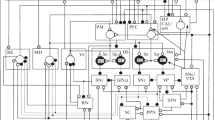Comparative studies of the GABAergic modulation of oscillations in neuron activity in the medial septal area were performed on living brain slices from healthy guinea pigs and animals with a model of chronic temporal epilepsy. Burst activity persisted only in pacemakers on administration of GABA in both groups of animals. The effectiveness of GABA on rhythmic neurons was sharply reduced in animals with epilepsy. In controls, cells maintaining oscillatory activity showed significant reductions in burst frequency on exposure to GABA, while burst frequency increased sharply in epileptic animals. Blockade of GABAergic receptors revealed impairment to tonic GABAergic intraseptal influences and a significant decrease in blocker efficacy in epilepsy. This report provides the first demonstration of impairments to the functional of the septal GABAergic system in temporal epilepsy, this being a possible cause for the sharp changes seen in the oscillatory properties of septal neurons. These data contribute to our understanding of the mechanisms of development of temporal epilepsy.
Similar content being viewed by others
References
A. E. Malkov, E. N. Karavaev, I. Yu. Popova, and V. F. Kichigina, “Changes in the oscillatory activity of neurons in the medial septal area in epileptic animals,” Zh. Vyssh. Nerv. Deyat., 57, No. 5, 615–621 (2007).
L. Colom, A. Garcia-Hernandez, M. Castaneda, M. Perez-Cordova, and E. Garrido-Sanabria, “Septo-hippocampal networks in chronically epileptic rats: potential antiepileptic effects of theta rhythm generation,” J. Neurophysiol., 95, 3645–3653 (2006).
M. Fedi, S. Berkovic, C. Marini, R. Mulligan, H. Tochon-Danguy, and D. Reutens, “A GABAA receptor mutation causing generalized epilepsy reduces benzodiazepine receptor binding,” Neuroimage, 32, 995–1000 (2006).
P. Follesa, A. Tarantino, S. Floris, A. Mallei, S. Porta, G. Tuligi, E. Cagetti, M. Caddeo, A. Mura, M. Serra, and G. Biggio, “Changes in the gene expression of GABAA receptor subunit mRNAs in the septum of rats subjected to pentylenetetrazol-induced kindling,” Mol. Brain Res., 70, 1–8, (1999).
Z. Henderson, G. Fiddler, S. Saha, A. Boros, and K. Halasy, “A parvalbumin-containing, axosomatic synaptic network in the rat medial septum: relevance to rhythmogenesis,” Eur. J. Neurosci., 19, 2753–2768 (2004).
Z. Henderson, N. Morris, P. Grimwood, G. Fiddler, H. Yang, and K. Appenteng, “Morphology of local axon collaterals of electrophysiologically characterised neurons in the rat medial septal/diagonal band complex,” J. Comp. Neurol., 430, 410–432 (2001).
V. F. Kitchigina and M. V. Butuzova, “Theta activity of septal neurons during different epileptic phases: the same frequency but different significance?” Exp. Neurol., 216, 449–458 (2009).
J. Miller, G. Turner, and B. Gray, “Anticonvulsant effects of experimental induction of hippocampal theta activity,” Epilepsy Res., 18, 195–204 (1994).
I. Popova,Y. Kokoz, K. Zenchenko, and O. Vinogradova, “The paradoxically high reactivity of septal neurons in hibernating ground squirrels to endogenous neuropeptides is lost after chronic deafferentation of the septum from the preopticohypthalamic areas,” Comp. Biochem. Physiol., 135, 383–402 (2003).
I. Y. Popova, V. V. Sinelnikova, and V. F. Kitchigina, “Disturbance of the correlation between hippocampal and septal EEGs during epileptogenesis,” Neurosci. Lett., 442, 228–233 (2008).
R. Vertes and B. Kocsis, “Brainstem-diencephalo-septo-hippocampal systems controlling the theta rhythm of the hippocampus,” Neuroscience, 81, 893–926 (1997).
O. S. Vinogradova, “Expression, control, and probable functional significance of the neuronal theta rhythm,” Prog. Neurobiol., 45, No. 6, 523–583 (1995).
O. S. Vinogradova, E. Brazhnik, A. Karanov, and S. Zhadina, “Neuronal activity of the septum following various types of deafferentation,” Brain Res., 187, 353–368 (1980).
C. Xu, S. Datta, M. Wu, and M. Alreja, “Hippocampal theta rhythm is reduced by suppression of the H-current in septohippocampal GABAergic neurons,” Eur. J. Neurosci., 19, No. 8, 2299–2309 (2004).
R. M. Yoder and K. C. Pang, “Involvement of GABAergic and cholinergic medial septal neurons in hippocampal theta rhythm,” Hippocampus, 15, No. 3, 381–392 (2005).
Author information
Authors and Affiliations
Corresponding author
Additional information
Translated from Zhurnal Vysshei Nervnoi Deyatel’nosti imeni I. P. Pavlova, Vol. 61, No. 3, pp. 377–382, May–June, 2011.
Rights and permissions
About this article
Cite this article
Malkov, A.E., Popova, I.Y. GABAergic Modulation of Oscillatory Activity in the Medial Septal Area in Epilepsy. Neurosci Behav Physi 42, 1055–1059 (2012). https://doi.org/10.1007/s11055-012-9678-8
Received:
Accepted:
Published:
Issue Date:
DOI: https://doi.org/10.1007/s11055-012-9678-8




